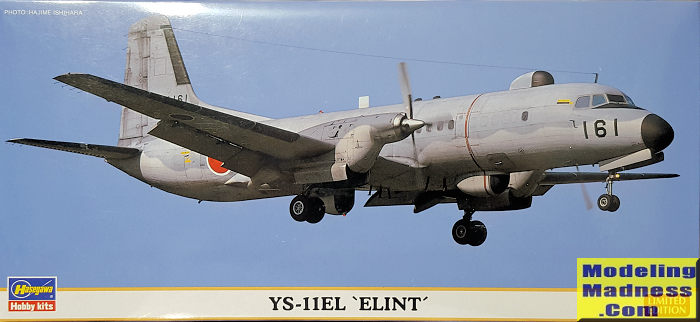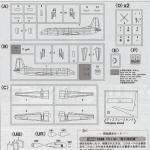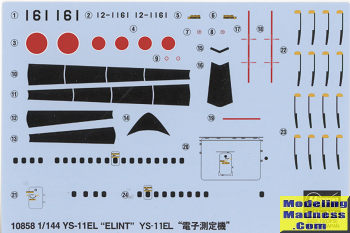
Hasegawa 1/144 YS-11EL 'Elint'
| KIT #: | 10858 |
| PRICE: | 3120 yen on sale (3900 yen SRP) |
| DECALS: | One option |
| REVIEWER: | Scott Van Aken |
| NOTES: | Includes resin parts. |

| HISTORY |
The YS-11 was slowly phased out by airlines in Japan due to new directives issued by the Ministry of Land, Infrastructure, Transport and Tourism requiring all commercial aircraft in Japan to be fitted with a Traffic Collision Avoidance System (TCAS). Aircraft without TCAS were forced to cease operations at the end of 2006. Since equipping a YS-11 with TCAS would have cost ¥100 million (about US$1 million), a refit was deemed economically unsound. Aircraft still in flying condition were sold to foreign companies. On September 30, 2006, Japan Air Commuter Flight 3806 marked the final flight for a YS-11 in Japan's commercial aviation industry. In 2007, the YS-11 was added to the Mechanical Engineering Heritage of Japan as item number 13. As of 2014, 15 were operated by the Japanese military, and two in Mexico.
The versions supplied to the Japanese military are the 'Super YS' with uprated engines. The type was retired from the JASDF in 2021 with the various special roles taken over by the JMSDF's EP-3Cs. I'm sure that this will be passed along to a P-1 variant once all aircraft are delivered.
| THE KIT |
 This
is one of those kits that often flies under the radar of most modelers, and it
is a shame as it builds into an excellent model. I've built the ANA airliner
version and found it to be well thought out. This one is a special boxing that
includes not only weights for the nose, but also several new pieces produced in
resin for all the various lumps and bumps that festoon this particular variant.
This
is one of those kits that often flies under the radar of most modelers, and it
is a shame as it builds into an excellent model. I've built the ANA airliner
version and found it to be well thought out. This one is a special boxing that
includes not only weights for the nose, but also several new pieces produced in
resin for all the various lumps and bumps that festoon this particular variant.
Unlike many kits, this one comes with a display stand, for which a hole will need to be opened in the fuselage halves prior to construction. Also one will need to cut away the various antennas already molded on the fuselage that are not pertinent to this version. There is a cockpit of sort with simply some seats molded to a forward section. It is to the back of this section that the weights are attached in a small cage made specifically for this purpose. There are no windows molded on the fuselage to allow the kit to be used for a variety of airlines and military liveries. These windows are provided on the decal sheet.
Engines are each three pieces and hold poly-caps for the props. Wings are an upper and lower section on each sied and include a rudimentary wheel well. The engine nacelles simply slide onto the front of the wing. Once the wings and the tail planes are attached to the fuselage, it is time to start attaching resin bits. These are all over the upper and lower as well as the side of the fuselage and the instructions show exactly where each one fits.
 One
can build the airplane in flight and separate closed gear door assemblies are
provided for this. Those wishing the plane on its wheels have nicely molded gear
on which to place the airplane. The last thing one does is insert the windscreen
and the props.
One
can build the airplane in flight and separate closed gear door assemblies are
provided for this. Those wishing the plane on its wheels have nicely molded gear
on which to place the airplane. The last thing one does is insert the windscreen
and the props.
Standard instructions for small Hasegawa kits provide Gunze color information. There is one markings option and that is for the plane operated by the ADC Headquarters squadron. It is painted in dark gull grey over light gull grey with a fairly solid camo demarcation line so masking would be the best option in this case. The decal sheet is well printed offering not only window decals but also the wing and prop anti-icing decals.
| CONCLUSIONS |
This will not only be a fairly trouble-free build, but provides a model of a kit that one rarely sees built. Well worth adding to your 1/144 collection.
January 2024
Copyright ModelingMadness.com. All rights reserved. No reproduction in
part or in whole without express permission from the editor. If you would like your product reviewed fairly and fairly quickly, please
contact
the editor
or see other details in the
Note to
Contributors.